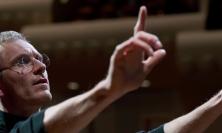During the first session of the Synod on Synodality (October 2023), many delegates were surprised, and consoled, to be introduced to the new 'digital continent' and the emerging mission of the Church 'there'. Cardinal Michael Czerny SJ considers how a concept that was key to Jesuit philosopher, Bernard Lonergan clarifies this new evangelisation and ministry as a radical inculturation; and how digital mission not only illustrates but actually enriches the meaning of Lonergan's ‘communications’.
The magnificent Method in Theology[i] of Bernard J.F. Lonergan SJ explains, distributes and interrelates all of the functions of theology. His formidable schema of eight functional specialties culminates with functional speciality (FS) 8, ‘Communications’.[ii] All the fruits of all theology for the Church and for humanity arrive and converge here, for FS 8 ‘is concerned with the effective communication of Christ’s message’.[iii] Without FS 8, ‘the first seven are in vain, for they fail to mature’.[iv]
For Lonergan, the word ‘communication’ encompasses the contents and the means of communication, and the relationships that it involves. All this clearly refers to the pastoral life of the Church. In fact, in the Romance languages, ‘pastoral’ is a noun, and were this possible in English, Lonergan could have simply called FS 8, ‘Pastoral’, which includes but is broader than ‘communications’.
A very new pastoral field for the Church is the mission in the digital environment or, more simply, the digital mission.[v] This paper is a dialogue between this new ‘pastoral’ and Lonergan’s FS 8, ‘Communications’. What light do they shed on one another?
The new world
At the start of 2024, some 5.35 billion people, 66% of the world, had access to the internet and social media.[vi] This, along with the uptake of artificial intelligence, is changing our reality in many more ways than we could previously have imagined.
The rapidly evolving digital environment is ‘increasingly present in the lives of children and families. While it has great potential to improve people's lives, it can also cause harm and injury’.[vii] Now ‘many young people have abandoned the physical spaces of Church’ and favour ‘instead online spaces’.[viii]
Such ambiguous and disconcerting phenomena are what Vatican II would include under ‘the signs of the times’, and these are ‘the joys and the hopes, the griefs and the anxieties of the people of this age’ that the council affirms as the Church’s own[ix] and where we should help make Christ present. One of the ‘Study Groups for questions raised in the First Session of the XVI Ordinary General Assembly of the Synod of Bishops’, Study Group 3 (SG 3) is working to help us make these phenomena our own and respond as a more synodal, more missionary Church.
Providentially, the October 2023 Synod was apprised of such signs, hopes and anxieties under the suggestive image of a new continent to be evangelised and brought, sacramentally, into the Church: ‘the digital mission is not merely a tool for evangelisation, but it is “a space, a territory… a new world for the Church of communion and mission”’.[x] This discovery (astonishing for the majority of Synod delegates) triggered in all of us – beginning with Pope Francis – deep and lively feelings of faith, hope, love and zeal.
So here, a bit more concretely, are our two reciprocal questions:
- How does Lonergan’s FS 8, ‘Communications’, help us ‘to grasp the importance for the Church of carrying out the mission of proclaiming the Gospel also in the digital environment’?[xi] How, consciously and intelligently, are we to include the digital mission in how the Church is becoming synodal?
- How does this decisive moment in church history – unimagined in Lonergan’s time – draw new meaning from FS 8? How does it require new collaborative work of theologians, and others in the human sciences and history, on FS1-7?
Inculturation
The digital environment is a culture, a ‘place’, where people – all of us – spend a significant part of our lives. Not just a tool or a technology, ‘digital culture represents a fundamental change in the way we conceive of reality and consequently relate to ourselves, one another, our surroundings, and even to God’.[xii] So, it is having ‘a profound impact on ideas of time and space, on our self-understanding, our understanding of others and the world, and our ability to communicate, learn, be informed and enter into relationship with others.’[xiii]
This requires dramatically new forms of mission ‘to reach today's culture in all spaces where people seek meaning and love, including the spaces they enter through their cell phones and tablets’.[xiv]
Nevertheless, to call these spaces ‘culture’ is truly disorienting since, until now, culture was always organically related to ‘real’ space, to ‘real’ place as its indispensable matrix. ‘The dualism between real and virtual does not adequately describe the reality and experience of people, especially the youngest, the so-called “digital natives”’.[xv] In recent years, we have seen that what starts and happens in the digital culture is generating great changes in the physical world, for example, the Arab Spring, the response to the death of George Floyd, the #MeToo movement, Mr Beast’s YouTube channel, and so many more.
Lonergan’s reasoning of a half-century ago expresses beautifully and precisely the challenge that the digital mission must face or, even more radically, the challenge that gives rise to the digital mission:
The Christian message is to be communicated to all nations. Such communication presupposes that preachers and teachers enlarge their horizon to include an accurate and intimate understanding of the culture and the language of the people they address. They must grasp the virtual resources of that culture and that language, and they must use those virtual resources creatively so that the Christian message becomes, not disruptive of the culture, not an alien patch superimposed upon it, but a line of development within the culture.[xvi]
As if responding to Lonergan, the Synod says that the Church is ready to carry out ‘the mission of proclaiming the Gospel also in the digital environment, which involves every aspect of human life and must therefore be recognised as a culture and not only as an area of activity’.[xvii]
Someone who attentively and intelligently tries to minister in the digital mission could be described by Lonergan like this: both the digital pastoral worker and the digital missionary ‘acknowledge a multiplicity of cultural traditions [and] would proceed from within [these] culture[s] and … seek ways and means for making [each culture] into a vehicle for communicating [inculturating] the Christian message’.[xviii]
The digital cultures are substantially new and rapidly evolving, while the constant introduction of new techniques and technologies is only incidental. The electronics is not the principal challenge, but rather the inculturation of the gospel and of church life.
Consequently, the Holy Father has ‘set up a Study Group to investigate the implications [of the digital mission] at the theological, spiritual and canonical level and identify the requirements at the structural, organisational and institutional level to fulfil the digital mission’.[xix]
‘Ours is a time of ever-increasing change due to an ever-increasing expansion of knowledge’, Lonergan says. He would thus explain the study group’s assignment: ‘To operate on the level of our day is to apply the best available knowledge and the most efficient techniques to coordinated group action’.[xx]
Evangelisation
‘The Christian Church is the community that results from the outer communication of Christ’s message and from the inner gift of God’s love. Since God can be counted on to bestow his grace’, the Synod has called our attention to an ‘effective communication of Christ’s message’.[xxi]
The digital mission began when social media, podcasts, blogs and YouTube were born. It is not waiting to be invented. Lay people, priests and religious did not wait for a mandate from the Vatican, their bishop or their superiors. Seeing souls wandering about in digital spaces in search of meaning, they took the initiative to introduce them to Christ’s love. The digital mission has been sprouting like the ‘seed scattered on the ground. Without [the farmer] knowing how, and whether sleeping or awake, day and night...’ (Mk 4:26-27), the seeds quietly germinate and begin growing, while SG 3 is preparing the ecclesial ‘ways and means’ that will be needed.
‘[T]he Christian message [is] conjoined with the inner gift of God’s love and result[s] in Christian witness [martyria], Christian fellowship [koinonia], and Christian service to [hu]mankind [diakonia].’[xxii] How do people live these three dimensions of our faith in relationship to their practice on earth? Are they to be lived differently, somehow, on the ‘digital continent’?
‘The Church … exists not just for itself but for [hu]mankind. Its aim is the realization of the kingdom of God not only within its own organization but in the whole of human society and not only in the after life but also in this life.’[xxiii] The Church needs to seek out and encounter the humankind for which it exists, not just spontaneously but organically, ecclesially.
Yet, a great majority of church leaders and church members have no idea about the digital continent waiting to be evangelised and ministered to, or of what digital missionaries and pastoralists – whether priest, religious or layperson, male or female, young or adult – are and do. In fact, they are offering significant pastoral formation and accompaniment to baptised Catholics online, as well as evangelisation aimed at lapsed Catholics and people who do not know Christ.
Thanks to these individual initiatives online, the statistics measuring participation in digital ministries and mission are way out of proportion to the number of people attending their local parish. For the Synod to pay attention to digital missionaries, and those pastorally accompanying Catholics and forming them online, was an important recognition and reality check.
Traditionally, missionaries have always been sent by their bishop or superior who accompanies them from afar and occasionally visits them. Today, many Catholic influencers (wherever ‘on earth’ they reside, whatever their age and background) need to meet their respective bishops to begin to dialogue and to discover the ecclesial dimension, the indispensable basis, of their ministry. ‘We need to provide opportunities for recognising, forming, and accompanying those already working as digital missionaries’.[xxiv]
So, when the Synod approved the Synthesis Report of the first session of the Synod, including section 17 on ‘Mission in the Digital Environment’ (SR 17), it was not launching a brand new idea to be ‘realised’ but rather learning from and building upon impressive evangelisation and ministry already ‘spontaneously’ underway.
Conclusion
We began with the question, ‘What light do Lonergan’s FS 8, and the Synod’s SR 17 and SG 3, shed on one another?’
Lonergan’s FS 8 sheds bright light on the magisterium of Pope Francis regarding the digital mission. It helps us to understand the new cultures within which people increasingly dwell and, indeed, are immersed and, therefore, the very dynamic inculturation required. ‘Missionaries have always gone with Christ to new frontiers, while the Holy Spirit pushed and preceded them’.[xxv] We can only regard this so-called new continent with the zeal of a Francis Xavier or a Mother Cabrini.
The magisterium of Pope Francis encouraging the digital mission sends us immediately to FS 8. The digital mission is born of the faith and of the Church, but in spontaneous and dispersed ways. Now both the Holy Father and the Synod are asking for the digital mission to be recognised and incorporated into the visible Church, and become a true ecclesial ministry and mission.
Is this the first time that very new forms of evangelisation and ministry have been embraced so quickly by the Church, with two official documents in less than six months since their introduction to the Synod? True, ‘we cannot evangelize digital culture without first understanding it’,[xxvi] and Lonergan would insist on understanding before communicating (FS 1-7 come before FS 8). Nevertheless, the digital mission as FS 8 – which we can call communications, pastoral life, pastoral or practical theology – really is an evangelical ‘driving force’ only beginning to connect with and benefit from FS 1-7.
Since Lonergan’s method is not linear but circular and dynamic, can one maybe start at FS 8 in the digital environment, patiently work through FS 1-7, and then return to enrich communications and pastoral life (FS 8)? Could this be what Lonergan really hoped for?
This we cannot know for certain. Armed, however, with the toolkit of his Method in Theology, let us initiate a wise hermeneutics of the present, which includes accelerating rapid change and astonishing digital innovations. Let us appreciate their great potential for dialogue – for example, with the joys and hopes, the sorrows and anxieties of today’s people, and especially of the young. In a new mission for a new world, let us courageously and creatively offer the Word of Truth revealed in Christ Jesus.
Cardinal Michael Czerny SJ is prefect of the Dicastery for the Promotion of Integral Human Development and a delegate to the Synod on Synodality. An earlier version of this text was delivered at the Pontifical Gregorian University on 7 May 2024.
For an alternative presentation of what the 'digital mission' is, please see this PDF poster.
[i] Bernard J.F. Lonergan, Method in Theology (N.Y.: Herder and Herder, 1972), chapter 14, ‘Communications’, henceforth, FS 8.
[ii] ‘Communications is concerned with theology in its external relations. These are of three kinds. There are interdisciplinary relations with art, language, literature, and other religions, with the natural human sciences, with philosophy and history. Further, there are the transpositions that theological thought has to develop if religion is to retain its identity and yet at the same time find access into the minds and hearts of men of all cultures and classes. Finally, there are the adaptations needed to make full and proper use of the diverse media of communication that are available at any place and time.’ (Lonergan, Method in Theology, pp. 132-33)
[iii] Lonergan, Method in Theology, p. 362.
[iv] Lonergan, Method in Theology, p. 355.
[v] XVI Ordinary General Assembly of the Synod of Bishops, Synthesis Report (4-29 October 2023), chapter 17 (henceforth SR 17): https://www.synod.va/content/dam/synod/assembly/synthesis/english/2023.10.28-ENG-Synthesis-Report.pdf; and General Secretariat of the Synod, ‘Study Groups for questions raised in the First Session of the XVI Ordinary General Assembly of the Synod of Bishops to be explored in collaboration with the Dicasteries of the Roman Curia’, Study Group 3 (henceforth SG 3): https://press.vatican.va/content/salastampa/en/bollettino/pubblico/2024/....
[vi] According to DataReportal, more than half of the world now uses social media (62.3%): https://datareportal.com/global-digital-overview.
[vii] SR 17f; cf. Pope Francis, ‘Artificial Intelligence and Peace’ (1 January 2024), on the ambiguities, promises and threats of new technologies: https://www.vatican.va/content/francesco/en/messages/peace/documents/202....
[viii] SR 17k.
[ix] Pope Paul VI, Gaudium et spes (1965), §1: https://www.vatican.va/archive/hist_councils/ii_vatican_council/document....
[x] José Manuel Urquidi and Sr Xiskya Lucia Valladares Paguaga RP, ‘Synod: Testimony on digital mission and Module 2’, https://www.vaticannews.va/en/vatican-city/news/2023-10/synod-eight-general-congregation-module-b2-urquidi-valladares.html, quoting Cardinal Tagle. They speak of digital evangelisers, especially lay and young, wanting ‘to better connect with our Bishops and Dioceses, and to be better accompanied, recognised, and integrated into the apostolic mission of the Church.’
[xi] SG 3, §1.
[xii] SR 17a.
[xiii] Pope Francis, Christus vivit (2019), §86 : https://www.vatican.va/content/francesco/en/apost_exhortations/documents....
[xiv] SR 17c.
[xv] SR 17a.
[xvi] Lonergan, Method in Theology, p. 362.
[xvii] SG 3, §1.
[xviii] Lonergan, Method in Theology, p. 363.
[xix] Pope Francis, ‘Letter to Cardinal Grech’ (22 February 2024): https://press.vatican.va/content/salastampa/en/bollettino/pubblico/2024/03/14/240314h.html. (SG 3 §3)
[xx] Lonergan, Method in Theology, p. 367.
[xxi] Lonergan, Method in Theology, pp. 361-2.
[xxii] Lonergan, Method in Theology, p. 363.
[xxiii] Lonergan, Method in Theology, p. 363-4.
[xxiv] SR 17L.
[xxv] SR 17c.
[xxvi] SR 17d.






